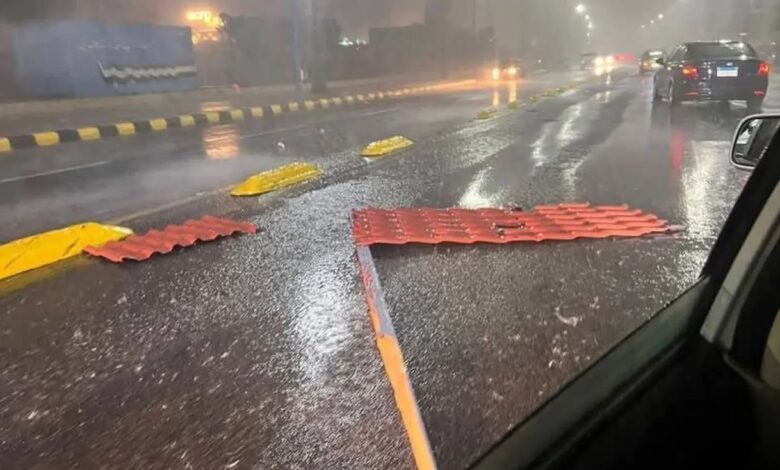
The city of Alexandria is facing a difficult environmental crisis, threatened not only by its low-lying coastal location but also by the advanced age of its infrastructure and vital networks.
As scientific warnings mount regarding the dangers of climate change and rapidly accelerating sea-level rise, attention is turning to the policies and technologies managing sewage and stormwaters as the city’s first line of defense against potential catastrophe.
This is magnified by the fact that tens of thousands of buildings — including those of unique architectural heritage — stand unprotected along the coastal strip.
Studies show a dramatic escalation in structural failures: the annual collapse rate has surged from approximately one incident at the turn of the millennium to nearly 40 collapses per year.
This crisis has resulted in the destruction of hundreds of buildings and threatens thousands more whose foundations rest on soil layers increasingly saturated with saltwater. The escalating intrusion of seawater into the subsoil is severely weakening foundations and accelerating the corrosion of concrete and metals.
This process speeds up structural cracking and building collapses, particularly in low-lying historical districts.
This geo-technical risk is compounded by the growing intensity of torrential rainfall. These severe weather events have recently overwhelmed stormwater drainage systems, causing major neighborhoods to flood and halting traffic for hours, and sometimes even days.
Coupled with the anticipated sea-level rise (projected to be 1.9 meters by the end of the century), this phenomenon is expected to drive Alexandria’s coastline further inland, resulting in widespread devastation to infrastructure, buildings, and the local economy.
It is therefore imperative to establish an integrated strategy that combines flood prevention with reinforced structural resilience and enhanced infrastructure.
Achieving environmental security for the city demands a resolute political will, strategic investments, and swift decision-making. This must be coupled with expanding international partnerships, collaborating with global institutions and expertise, and integrating the findings of modern academic and field studies to preserve the heart of the Mediterranean and its architectural heritage for future generations, especially in this era of severe climate change.
Technological and field evidence demonstrates that Japanese drainage techniques have proven effective in tackling flood disasters and land subsidence.
However, their transfer to Alexandria requires local adaptation and harmonization.
These Japanese technologies are not just applicable in Alexandria; they are essential for confronting the twin challenges of flooding and building collapse. By combining technical innovation with strategic planning, Alexandria can be transformed into a resilient city capable of withstanding natural disasters.
Disaster protection is not a luxury; it is an investment in the future.
The Japanese experience offers essential separation techniques for vital networks: segregating sanitation systems (domestic and industrial wastewater) from dedicated stormwater drainage networks.
The latter utilize deep underground tunnels for collection, which serves to protect groundwater quality, prevent soil erosion, and support the growth of urban vegetation and tree canopy covers—ultimately boosting the city’s resilience against disasters.
This model develops innovative technology, employing advanced treatment, biological digesters, and green infrastructure as scientifically practical alternatives that can contribute to saving Alexandria from the risks of inundation and structural collapse.
Japan’s success in adapting to climate fluctuations stems from its adoption of AI-driven systems and widespread smart sensors for flood prediction within the drainage network.
These sensors are linked to real-time monitoring and control platforms that operate in harmony with digital weather models and forecasts.
They alert authorities to any dangerous changes and automatically activate pumps and valves to redirect water or store it in massive temporary underground reservoirs, as exemplified by the Tokyo and Kasukabe systems.
Furthermore, Japanese practices involve introducing inspection robots inside sewage pipes to monitor damage and corrosion.
Artificial Intelligence is used to analyze historical data and predict areas most susceptible to collapse or blockage before issues escalate, ensuring safe drainage during emergencies and extending the network’s virtual lifespan.
Central and decentralized treatment plants in Japan represent a cornerstone of environmental engineering.
They utilize a blend of primary, biological (aerobic and anaerobic), tertiary treatment, and modern membrane technologies. Operations focus on removing organic matter, heavy metals, and nutrients (nitrogen and phosphorus).
Some processes even include advanced stages like ozone, activated carbon, and reverse osmosis to achieve flexible biological quality indicators.
Japan’s Johkasou system is a hallmark of decentralized sanitation management. It combines easy transport and installation with high efficiency in removing organic matter and nutrients from domestic wastewater for buildings not connected to public networks.
The system can be customized based on population and building size, employing biological processes, membrane treatment, and electro-coagulation for highly efficient nitrogen and phosphorus removal. The treated water is then used for agriculture, cleaning, or flushing, while collected sludge is converted into fertilizer or fuel.
The Johkasou system thus encompasses an integrated governance framework for monitoring, maintenance, and inspection, an approach that elevates operational efficiency and prevents sudden malfunctions that could threaten building safety or the environment.
It utilizes anaerobic digestion, where the sludge resulting from wastewater treatment is converted into methane.
This gas is then harnessed to generate electricity or heat for the treatment plants themselves and for local consumption, thereby helping to halve waste volume and providing a clean, renewable energy source.
Furthermore, it offers a qualitative solution for producing high-quality organic fertilizers free of hazardous impurities.
There are existing examples of Egyptian-Japanese cooperation in sanitation and future projects. Egypt’s water and wastewater sector has seen a series of partnerships with Japan, extending from technological and technical support to education, training, and knowledge transfer.
On September 18,, a memorandum of cooperation was signed between Egypt’s National Authority for Military Production and a Japanese company to develop atmospheric water generation stations.
This project aims to enhance water resilience in areas threatened by drought, particularly coastal cities like Alexandria, fostering integration between water needs and climate disaster management—a model that ought to be expanded.
Author’s biography
Abeer Bassiouny Radwan is an Egyptian academic and diplomat.
Her diplomatic tenure was highly focused on development and humanitarian cooperation in Africa.
Academically, she holds a Ph.D. in International Relations from Cairo University, specializing in topics related to the World Trade Organization (WTO), in addition to an MBA from Maastricht University.
Radwan remains actively engaged in public discourse as a notable opinion author for major Egyptian publications, including Al-Ahram Daily and Al-Masry Al-Youm.




